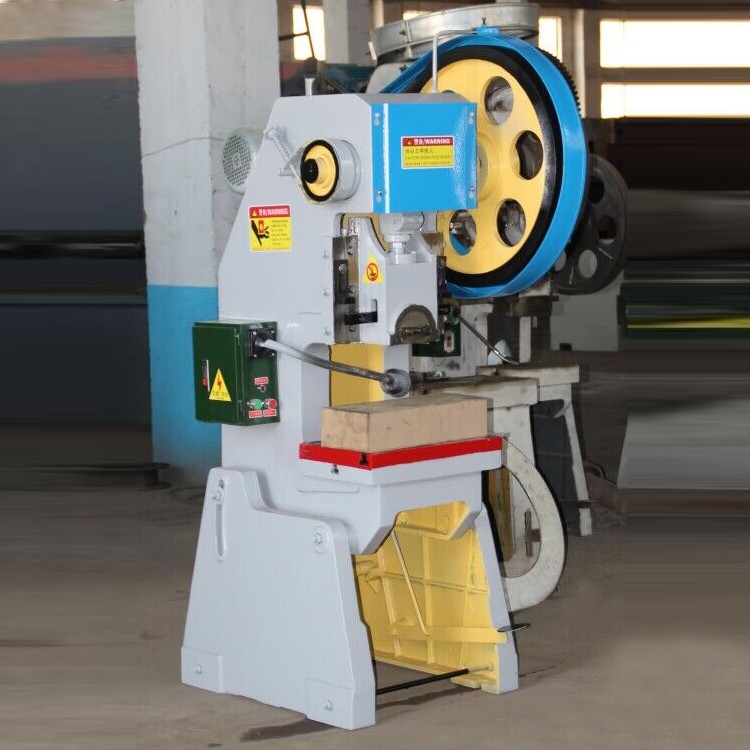

We are a professional punching machines manufacturer with over 10 years of industry experience. Today, we would like to introduce the working principle of punch press to you:

A punching machine is essentially an energy conversion system that converts the rotational kinetic energy of an electric motor into mechanical energy that deforms the material. This process involves three key physical principles: Force amplification mechanisms, plastic deformation of the material and shear damage.
1, Force Amplification Mechanism
The heart of a punch press lies in the generation of a large punching force with a small input force. Take the example of a mechanical press:
The electric motor drives the flywheel to rotate and store kinetic energy, which is connected to the crankshaft through a clutch.
The rotary motion of the crankshaft is converted into a linear motion of the slide by means of a connecting rod. This conversion utilizes the principle of leverage: The ratio of the crankshaft radius (R) to the length of the connecting rod (L) determines the amplification of the force. The mechanical gain is maximized when the crankshaft is rotated to lower dead center, at which point the slider can generate hundreds of tons of pressure even though the motor output torque is low.
Hydraulic presses amplify pressure through Pascal's principle: The hydraulic pump applies pressure (P) to the confined fluid, and the product of the cylinder piston area (A) and pressure (F=P×A) forms a huge output force.
2, The plastic deformation of the material
When the impulse pressure acts on the metal plate, the material undergoes two stages:
Elastic deformation: The initial pressure to make the metal lattice structure of reversible deformation, at this time, the withdrawal of the external force material will be restored to its original state.
Plastic deformation: When the stress exceeds the yield strength of the material (e.g. the yield strength of Q235 steel is 235 MPa), the lattice slips to produce permanent deformation. At this point the shape of the mold cavity determines the final form of the material. For example:
Bending: When the upper mold is pressed down, the outer neutral layer of the plate is subjected to tensile stresses and the inner to compressive stresses, resulting in overall bending.
Extension molding: The material flows under the action of the convex die, reducing the thickness but increasing the surface area.
3, Shear destruction (punching principle)
Punching is a typical application of punching machines, the essence of which is the process of shear destruction:
When the upper mold (punch) contact plate, the first in the contact surface to produce compressive stress.
As the pressure increases, the maximum shear stress within the material reaches the shear strength (approximately 0.7 times the tensile strength) and the grain boundaries begin to fracture.
The fracture process is divided into four stages:
Elastic deformation: Slight depression of the material
Plastic extrusion: The edge of the punch cuts into the material
Crack initiation: Micro-cracks appear in the material on the side of the punch
Fracture separation: Cracks extend to the concave side of the die and the waste material is dislodged
The punching gap (usually taken as 5-10% of the thickness of the material) determines the quality of the cross-section: A gap that is too small results in a secondary shear, while a larger gap produces a burr.
4, The embodiment of energy conservation
The whole stamping process follows the law of energy conservation:
Input of electric energy into the motor (E₁) → Kinetic energy stored in the flywheel (E₂ = ½Iω²) → Deformation work (E₃ = ∫F-ds)
Among them, about 15% of the energy is consumed in the friction heat, and the rest is transformed into the deformation energy of the material and the acoustic energy. The effect of inertial forces also needs to be taken into account when stamping at high speeds.
The principle of operation of a Punching machine is essentially the interaction of mechanical energy with the mechanical properties of the material. A system of force amplification is used to obtain a pressure sufficient to exceed the yield strength of the material, and a die is used to control the path of deformation and ultimately achieve a precise finish. Understanding these principles, it is clear why adjustments to press speed, die clearance or material thickness can have a direct impact on product quality. This type of processing, based on the laws of physics, is the fundamental reason why presses are so efficient and reliable.
If you are interested in punching machines, please contact us.
 Address:Room 1202, Detaitang Building, No. 118 Huaguang Road, Zhangdian District, Zibo, Shandong
Address:Room 1202, Detaitang Building, No. 118 Huaguang Road, Zhangdian District, Zibo, Shandong WhatsApp:+8615653328535
WhatsApp:+8615653328535 Wechat: +8615965331535
Wechat: +8615965331535  E-mail:zs@sdsmachinery.com
E-mail:zs@sdsmachinery.com